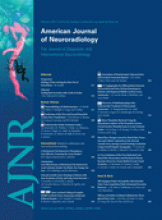Abstract
BACKGROUND AND PURPOSE: Stroke volume, an increasingly used end point in phase II trials, is considered stationary at least 30 days after the ictus. We investigated whether information conveyed by MR imaging measurements of the “final” infarct volume could be assessed as early as the subacute stage (days 3–6), rather than waiting for the chronic stage (days 30–45).
MATERIALS AND METHODS: Ninety-five patients with middle cerebral artery stroke prospectively included in a multicenter study underwent MR imaging during the first 12 hours (MR imaging-1), between days 3 and 6 (MR imaging-2), and between days 30 and 45 (MR imaging-3). We first investigated the relationship between subacute (FLAIR-2) and chronic volumes (FLAIR-3), by using a linear regression model. We then tested the relationship between FLAIR volumes (either FLAIR-2 or FLAIR-3) and functional disability, measured by the mRS at the time of MR imaging-3, by using logistic regression. The performances of the models were assessed by using the AUC in ROC.
RESULTS: A linear association between log FLAIR-2 and log FLAIR-3 volumes was observed. The proportion of FLAIR-3 variation, explained by FLAIR-2, was high (R2 = 81%), without a covariate that improved this percentage. Both FLAIR-2 and FLAIR-3 were independent predictors of mRS (OR, 0.79 and 0.73; 95% CI, 0.64–0.97 and 0.56–0.96; P = .026 and .023). The performances of the models for the association between either FLAIR volume and mRS did not differ (AUC = 0.897 for FLAIR-2 and 0.888 for FLAIR-3).
CONCLUSIONS: Stroke damage may be assessed by a subacute volume because subacute volume predicts the “true” final volume and provides the same clinical prognosis.
Abbreviations
- ADC
- apparent diffusion coefficient
- AUC
- area under the curve
- BI
- Barthel index
- CI
- confidence interval
- DWI
- diffusion-weighted imaging
- ECASS
- European Cooperative Acute Stroke Study
- EPITHET
- Echo-Planar Imaging Thrombolytic Evaluation Trial
- FLAIR
- fluid-attenuated inversion recovery
- ICA
- internal carotid artery
- log
- logarithmic
- MRA
- MR angiography
- mRS
- modified Rankin Scale, NIHSS =
- National Institutes of Health Stroke Scale; OR
- odds ratio
- PH
- parenchymal hematoma
- PWI
- perfusion-weighted imaging
- Q1-Q3
- first and third quartile of interquartile range
- ROC
- receiver operating characteristic analysis
- TP
- time point
- TTP
- time-to-peak
- VIRAGE
- Valeur predictive des paramètres IRM à la phase aigue de l'Accident vasculaire cerebral: application à la Gestion des Essais thérapeutiques
- Copyright © American Society of Neuroradiology
Indicates open access to non-subscribers at www.ajnr.org












